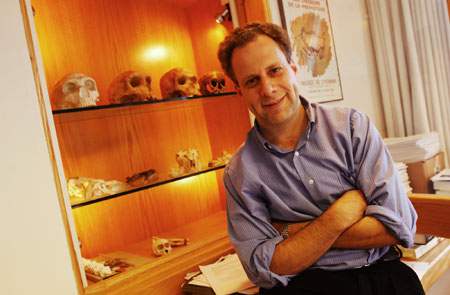Heads Up: Looking at the changing face of humanity

Chewing has changed the face of humankind.
“Our faces have gotten significantly smaller since our distant ancestors lived in caves,” says Daniel Lieberman, newly tenured professor of biological anthropology. “They are also smaller than the faces of our ancestors who lived only 300 years ago.”
The reason is that we are chewing less. A change from hard, rough foods to a diet of softer, processed food requires less chewing force, leading to smaller jaws and jaw muscles.
One disadvantage of a shrinking face turns out to be the painful growth of wisdom teeth. Genes largely control tooth size, while lessening the mechanical load of chewing is responsible for shrinking our jaws. As a result, our jaws have run out of room for these big teeth to grow in easily.
Lieberman is trying to determine how humans became humans, and he’s finding some good answers in our faces and skulls. How, for example, do we hold our heads stable enough for our eyes to focus when we run? Running or walking causes your head to bounce up and down, which should make it difficult to see clearly what’s ahead.
“We have a large ligament running from our spines to the back of our heads like a big rubber band,” Lieberman explains. “It acts like a spring to dampen the oscillations of our heads. Chimps and gorillas, with whom we share ancestors, do not have this mechanism.”
Neanderthals boasted buns of bone on the back of their skulls, which probably reduced head bouncing. “We think the buns provided counterbalancing, moving the center of gravity of their massive heads back toward their necks,” Lieberman notes. “It’s one of the differences between Neanderthals and modern humans that we’re studying.”
Neanderthals and other almost-humans possessed massive football shaped heads; our skulls are rounded like soccer balls. Heavy brow ridges and a huge face that jutted forward characterize Neanderthals, but not our species. What caused the differences?
“The surprising thing is that many of the changes between Neanderthal and modern human skulls can come from just a few small shifts in bone,” answers Lieberman. Take the cranial base, for example, a layer of bone below your brain and above your face. Lieberman calls it the “foundation” of the skull. A few minor changes in shapes of bones that make up the cranial base appear to cause most of the differences in head shape between Neanderthals, other proto-humans, and ourselves.
“We’re trying to determine if changes in the shape of the brain influence the cranial base,” Lieberman explains. “And what survival advantages you get with changes in the shape of your head and face.”
Changing a life
Lieberman, 37, began to get interested in the changes that make us what we are during his freshman year at Harvard in 1982.
“I took a terrific seminar on human evolution taught by David Pilbeam (now curator of anthropology at the Peabody Museum and Ford Professor of the Social Sciences),” he recalls. “It changed my life. Before that, I would have bet large sums of money that I would become a geologist. But I got extremely interested in human evolution and wound up publishing a scientific paper with Pilbeam during my freshman year. I thought, ‘Wow, if I can publish a paper in my first year, this is the field for me.’”
Coming back to Harvard this year, Lieberman now teaches a similar freshman seminar. “It’s weird and it’s terrific,” he remarks. “They’re a terrific, lively bunch – the kind of students you miss when you go somewhere else.”
After settling on anthropology, Lieberman earned an undergraduate degree here in 1986, a master’s in 1990, and a Ph.D. in 1993. He worked a lot with Alfred Crompton, curator of mammalogy at the Museum of Comparative Zoology and Fisher Research Professor of Natural History, who steered him to experimental work. “That was a good thing,” Lieberman comments. “I enjoy fieldwork but I never found anything important. I organized two expeditions to Kenya. On one, we found nothing, on the other I got incredibly sick. Nobody in their right mind would pay me to do fieldwork.”
Shedding tears over Lucy
Lieberman served as a tutor at Dunster House from 1988 to 1992, where he became well-known for organizing an annual goat roast. Done in conjunction with a course in human evolution, the students had to butcher the goat with stone tools, just as their Cro-Magnon ancestors did. Once that work was finished, other students joined the party. “It eventually evolved into a kind of bacchanalian feast,” he remembers.
After a junior fellowship in the Society of Fellows, Lieberman left to join the faculty at Rutgers University in New Jersey then at George Washington University in the District of Columbia. Now he’s back in a bright, roomy office on the fifth floor of the Peabody Museum.
“Anyone who complains about Harvard should be sent away for a while,” he says with a grin. “I was ready to leave here after 13 years, but I soon missed the resources, students, academic strengths, and terrific colleagues at Harvard. They’re amazing, particularly in anthropology and archaeology.
Lieberman vividly remembers escorting a group of Russian anthropologists through the Peabody Museum when he was a graduate student. During the tour, he opened a drawer containing a body cast of Lucy, a famous human ancestor who walked upright on the plains of East Africa about 3.2 million years ago.
“It didn’t seem like a special thing to me,” Lieberman says. “I took resources like it for granted. But a Russian paleontologist who was considered an expert on this species had never before seen casts of Lucy’s remains. She was so overwhelmed that she started to cry.”




